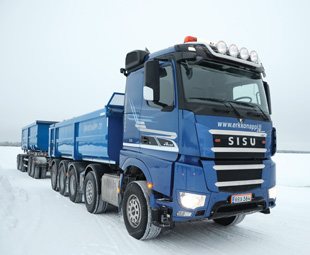“Monster” trucks in the Arctic

In Finland, nine-axle, 76-t GCW, longer truck-trailer combinations are becoming increasingly popular. This is the story of two such monster trucks: a Volvo Trucks FH 16-750 timber truck and a Sisu Polar gravel dump truck.
In Finland, the total timber truck market ranges between 150 and 250 new trucks per year. On average, these trucks are changed every five years, and reach a total mileage of 150 000 to 250 000 km per year. In 2013 the Finnish Government approved the new weight limit on the basis of a proposal of the Ministry of Transportation. These are the details of two of the biggest and baddest …
Volvo Trucks FH 16-750 range
The FH 16 combination is made up of a four-axle truck – with a 16,1-litre D16K 558 kW (750 hp), 3 550 Nm peak torque engine – and a five-axle trailer. According to Finnish regulation, the 76 t GCW is allowed for (at least) a nine-axle combination, provided that at least 65 percent of the mass of the trailer is on axles fitted with twin tyres.
The FH 16-750 is fitted with several timber-truck-specific technical features. It’s a full-pneumatic suspension 8×4 rigid, with second liftable axle. The full-pneumatic solution, which is gaining more and more success among Volvo timber trucks, now accounts for 85 percent of Volvo timber trucks sale volumes in Finland (where Volvo has about 50 percent of the total market in this segment).
Five years ago, the percentage of full-pneumatic suspension was no more than five percent. The full-pneumatic solution allows the driver to lift an axle to increase the grip of driven axles. In addition, the driver can dump air from the suspension of one of the driven axles to increase the grip of the other.
Other technical features of the FH 16-750 timber truck include special software for Volvo’s I-shift automated transmission, to cope with the extremely demanding conditions of timber transport along narrow and sometimes inadequate forest roads. Moreover, the truck is fitted with a hill-holder system, differential lock, sand splitter device (to increase the grip of driven axles) and a timber crane.
 Another key feature of the FH 16-750 timber truck is Volvo’s dynamic steering, which automatically dampens the irregularities of road surfaces, such as compacted snow or ice slabs. This decreases the driver’s workload, because he does not have to compensate for such irregularities.
Another key feature of the FH 16-750 timber truck is Volvo’s dynamic steering, which automatically dampens the irregularities of road surfaces, such as compacted snow or ice slabs. This decreases the driver’s workload, because he does not have to compensate for such irregularities.
Along public and narrow forest roads Dynamic steering really makes the difference. Despite the longer dimension (24 m long) and higher centre of gravity (4,4 m maximum height), the nine-axle truck-trailer combination proved to be easy to drive and stable, because the five-axle, twin-tyre trailer followed the truck smoothly, without any problem.
In Finland, we experienced a standard working day of a timber truck from Kontio – a world market leader, loghouse production HQ in Pudasjärvi, 700 km north of Helsinki – to an Arctic pine forest and back. Climate conditions were pretty good, because of the sun and a relatively mild temperature by Finnish winter standards (-17° C).
According to experienced timber truck drivers, the most demanding conditions occur on icy and slippery surfaces when the temperature is around zero and in deep-frozen conditions, when temperature drops to -35 or even -40° C. In those circumstances, the natural rubber of Scandinavian winter tyres becomes tougher and friction on slippery surfaces becomes more problematic.
During the empty trip, from Kontio HQ to the Arctic pine forest, we got stuck in the soft snow of a narrow forest road. We tried – without any result – to lift an axle to increase the grip of the driven axles of our 8×4 timber truck. Then, we tried to clear the snow from driven axles using a shovel. We also tried to reposition the trailer, using the timber crane fitted on the truck. Since we achieved no result, we asked for help … a snowplough finally solved our problem.
Loading cut-to-length tree trunks, prepared by a harvester, takes about 30 minutes in standard operating conditions. Roundwoods trucks are typically owned by family enterprises situated in the countryside, where the entrepreneur actively participates.
According to 2010 statistics, there are about 900 timber trucking entrepreneurs, employing 2 600 truck drivers, with a fleet of 1 700 trucks. The average number of trucks per enterprise is less than two.
Sisu Polar Euro-6 range
The second 76-t nine-axle combination tested in Finland was a Sisu Polar Rock gravel truck-trailer, 21,89 m in length. The 10×4 rigid was fitted with a Euro-6, six-in-line, 15,6-litre Mercedes-Benz OM 473 engine. It is rated at 465 kW (625 hp) and 3 000 Nm peak torque, and features a high-performance engine brake.
Engine power is transmitted to rear axles by a Mercedes-Benz Powershift 3,16-speed automated transmission – as in the vehicle under test – or by an optional Eaton Fuller RTLO22198B 18-speed unsynchronised manual gearbox.
 The Sisu Polar 10×4 proved to be easy to manoeuvre, thanks to its three steering axles. The first axle can be steered by 30°, the second by 16°, while the fifth can be counter-steered by 13°. In this configuration, the turning radius of the entire 21,89 m combination is 12,5 m.
The Sisu Polar 10×4 proved to be easy to manoeuvre, thanks to its three steering axles. The first axle can be steered by 30°, the second by 16°, while the fifth can be counter-steered by 13°. In this configuration, the turning radius of the entire 21,89 m combination is 12,5 m.
On uneven surfaces, such as compacted snow and/or ice slabs, or during tight manoeuvres with a 76 t GCW, the Servotwin steering system with electronic power steering makes the difference in terms of comfort for the driver (because less corrections of the steering wheel are needed) and vehicle handling. The OM 473 engine brake, with a maximum braking power of 475 kW, can substitute foundation brakes in 90 percent of the operating conditions.
Despite the full-mechanical suspension system, driving comfort in on-road applications proved to be quite high. Sisu Polar features two frame heights: 300 mm U-profile with inner reinforcement, and 460 mm C-profile for heavy-duty tasks.
Cab, engine, transmission and core electrical/electronic systems of the Sisu Polar are based on Mercedes-Benz Arocs technology. The Sisu Polar line-up includes Sisu Rock dump trucks, Sisu Works road maintenance trucks, Sisu Timber timber trucks, Sisu Roll demountable trucks and Sisu Carrier machine transport trucks. In addition to these models, Sisu Work plus is now available, which features a combination of road maintenance and demountable applications.
Heavier combinations in Finland
The 76-t nine-axle combinations are not the heaviest in Finland. Five special permits for 33-m, 80-t truck-combinations have been granted, so far, to Speed to run on six different road channels, and one 31-m, 94-t permit to Orpe. Some 10 to 15 more applications by three other companies have been handed to the road safety authority, Trafi, and to the Ministry of Transport.
Orpe is the only transport company with a permit to run with a 31-m (94-t 12-axle timber truck on specified conditions. The trial period runs until December 31, 2019. The application was originally for 102 t according to axle weights of 12 axles.
Only specially trained drivers are accepted and the vehicles can only run on roads and routes approved by the ministry. All brakes have to be electric EBS. Operation is forbidden when weather conditions and/or forecasts by the Meteorological Institute are declared “very bad”. The behaviour of the whole vehicle combination has to be continuously controlled by cameras on the vehicle. A report of the routes driven and the behaviour of the vehicle and of road conditions have to be delivered monthly to Trafi, and the entire vehicle combination has to be passed on to the authorities for testing, for no longer than three days, whenever Trafi or the ministry gives notice.
As regular readers of FOCUS know, this magazine has been appointed an associate member of the International Truck of the Year (IToY)! FOCUS is the sole South African magazine to have joined this prestigious body. One of the advantages of this association is access to exclusive articles, specially written for FOCUS by ITOY jury members. This is one such article.
Published by
Focus on Transport
focusmagsa




